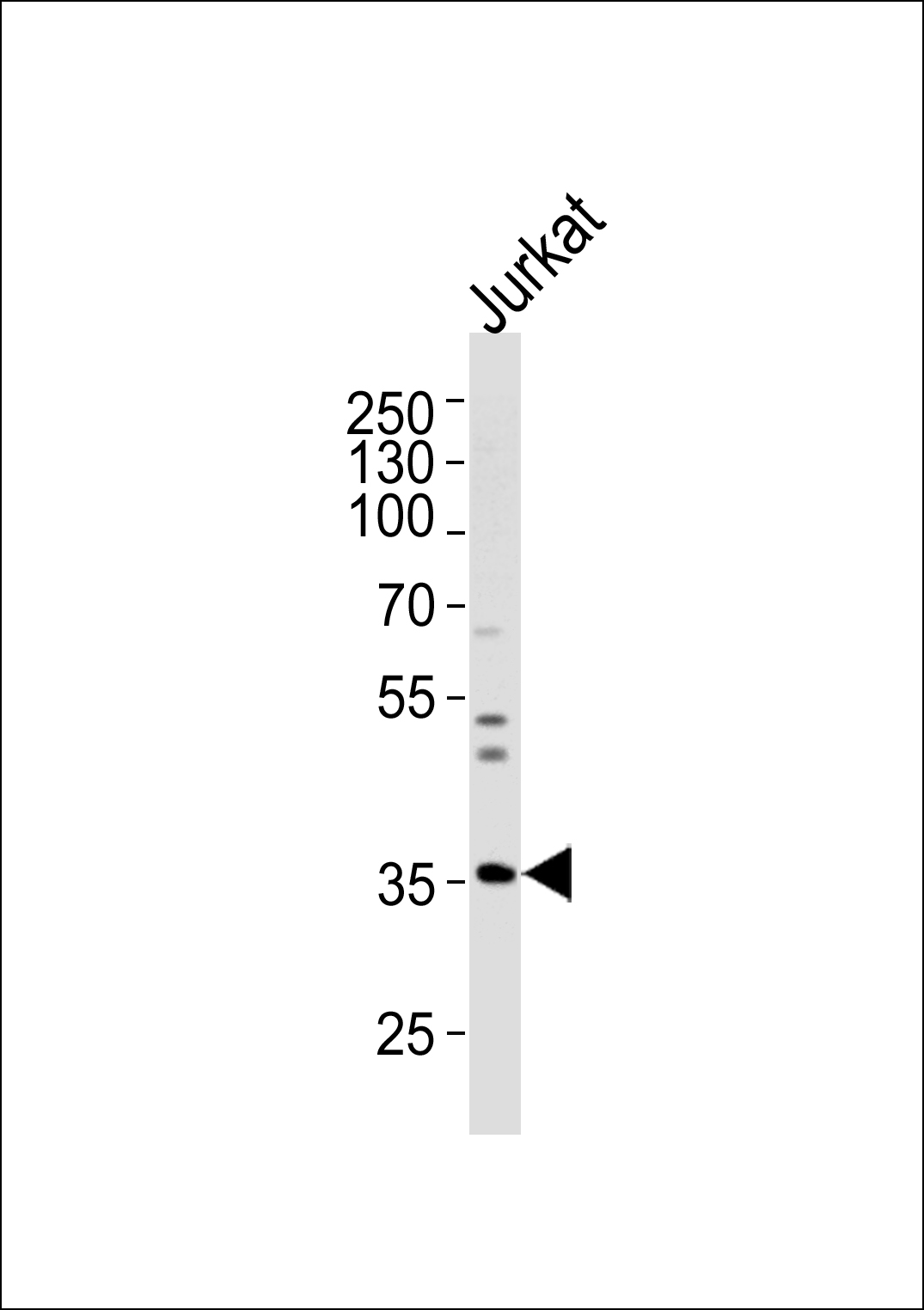GLRB Antibody (N-term)
Affinity Purified Rabbit Polyclonal Antibody (Pab)
- SPECIFICATION
- CITATIONS
- PROTOCOLS
- BACKGROUND

Application
| WB, E |
|---|---|
| Primary Accession | P48167 |
| Other Accession | P20781, P48168, Q9GJS9, NP_001159532.1, NP_000815.1 |
| Reactivity | Human |
| Predicted | Bovine, Mouse, Rat |
| Host | Rabbit |
| Clonality | Polyclonal |
| Isotype | Rabbit IgG |
| Calculated MW | 56122 Da |
| Antigen Region | 103-132 aa |
| Gene ID | 2743 |
|---|---|
| Other Names | Glycine receptor subunit beta, Glycine receptor 58 kDa subunit, GLRB |
| Target/Specificity | This GLRB antibody is generated from rabbits immunized with a KLH conjugated synthetic peptide between 103-132 amino acids from the N-terminal region of human GLRB. |
| Dilution | WB~~1:1000 |
| Format | Purified polyclonal antibody supplied in PBS with 0.09% (W/V) sodium azide. This antibody is purified through a protein A column, followed by peptide affinity purification. |
| Storage | Maintain refrigerated at 2-8°C for up to 2 weeks. For long term storage store at -20°C in small aliquots to prevent freeze-thaw cycles. |
| Precautions | GLRB Antibody (N-term) is for research use only and not for use in diagnostic or therapeutic procedures. |
| Name | GLRB |
|---|---|
| Function | Glycine receptors are ligand-gated chloride channels. GLRB does not form ligand-gated ion channels by itself, but is part of heteromeric ligand-gated chloride channels. Channel opening is triggered by extracellular glycine (PubMed:8717357, PubMed:15302677, PubMed:16144831, PubMed:22715885, PubMed:25445488, PubMed:11929858, PubMed:23238346, PubMed:34473954). Heteropentameric channels composed of GLRB and GLRA1 are activated by lower glycine levels than homopentameric GLRA1 (PubMed:8717357). Plays an important role in the down-regulation of neuronal excitability (PubMed:11929858, PubMed:23238346). Contributes to the generation of inhibitory postsynaptic currents (PubMed:25445488). |
| Cellular Location | Postsynaptic cell membrane {ECO:0000250|UniProtKB:P48168}; Multi-pass membrane protein {ECO:0000250|UniProtKB:P23415}. Synapse {ECO:0000250|UniProtKB:P48168} Cell projection, dendrite {ECO:0000250|UniProtKB:P48168}. Cell membrane; Multi-pass membrane protein {ECO:0000250|UniProtKB:P23415}. Cytoplasm Note=Retained in the cytoplasm upon heterologous expression by itself Coexpression with GPHN promotes expression at the cell membrane (PubMed:12684523). Coexpression with GLRA1, GLRA2 or GLRA3 promotes expression at the cell membrane. {ECO:0000250|UniProtKB:P20781, ECO:0000269|PubMed:12684523} |

Thousands of laboratories across the world have published research that depended on the performance of antibodies from Abcepta to advance their research. Check out links to articles that cite our products in major peer-reviewed journals, organized by research category.
info@abcepta.com, and receive a free "I Love Antibodies" mug.
Provided below are standard protocols that you may find useful for product applications.
Background
This gene encodes the beta subunit of the glycine receptor, which is a pentamer composed of alpha and beta subunits. The receptor functions as a neurotransmitter-gated ion channel, which produces hyperpolarization via increased chloride conductance due to the binding of glycine to the receptor. Mutations in this gene cause startle disease, also known as hereditary hyperekplexia or congenital stiff-person syndrome, a disease characterized by muscular rigidity. Alternative splicing results in multiple transcript variants.
References
Joslyn, G., et al. Alcohol. Clin. Exp. Res. 34(5):800-812(2010)
Wheeler, H.E., et al. PLoS Genet. 5 (10), E1000685 (2009) :
Ziegler, E., et al. Naunyn Schmiedebergs Arch. Pharmacol. 380(4):277-291(2009)
Tabakoff, B., et al. BMC Biol. 7, 70 (2009) :
Ahrens, J., et al. Pharmacology 83(4):217-222(2009)
If you have used an Abcepta product and would like to share how it has performed, please click on the "Submit Review" button and provide the requested information. Our staff will examine and post your review and contact you if needed.
If you have any additional inquiries please email technical services at tech@abcepta.com.













 Foundational characteristics of cancer include proliferation, angiogenesis, migration, evasion of apoptosis, and cellular immortality. Find key markers for these cellular processes and antibodies to detect them.
Foundational characteristics of cancer include proliferation, angiogenesis, migration, evasion of apoptosis, and cellular immortality. Find key markers for these cellular processes and antibodies to detect them. The SUMOplot™ Analysis Program predicts and scores sumoylation sites in your protein. SUMOylation is a post-translational modification involved in various cellular processes, such as nuclear-cytosolic transport, transcriptional regulation, apoptosis, protein stability, response to stress, and progression through the cell cycle.
The SUMOplot™ Analysis Program predicts and scores sumoylation sites in your protein. SUMOylation is a post-translational modification involved in various cellular processes, such as nuclear-cytosolic transport, transcriptional regulation, apoptosis, protein stability, response to stress, and progression through the cell cycle. The Autophagy Receptor Motif Plotter predicts and scores autophagy receptor binding sites in your protein. Identifying proteins connected to this pathway is critical to understanding the role of autophagy in physiological as well as pathological processes such as development, differentiation, neurodegenerative diseases, stress, infection, and cancer.
The Autophagy Receptor Motif Plotter predicts and scores autophagy receptor binding sites in your protein. Identifying proteins connected to this pathway is critical to understanding the role of autophagy in physiological as well as pathological processes such as development, differentiation, neurodegenerative diseases, stress, infection, and cancer.


